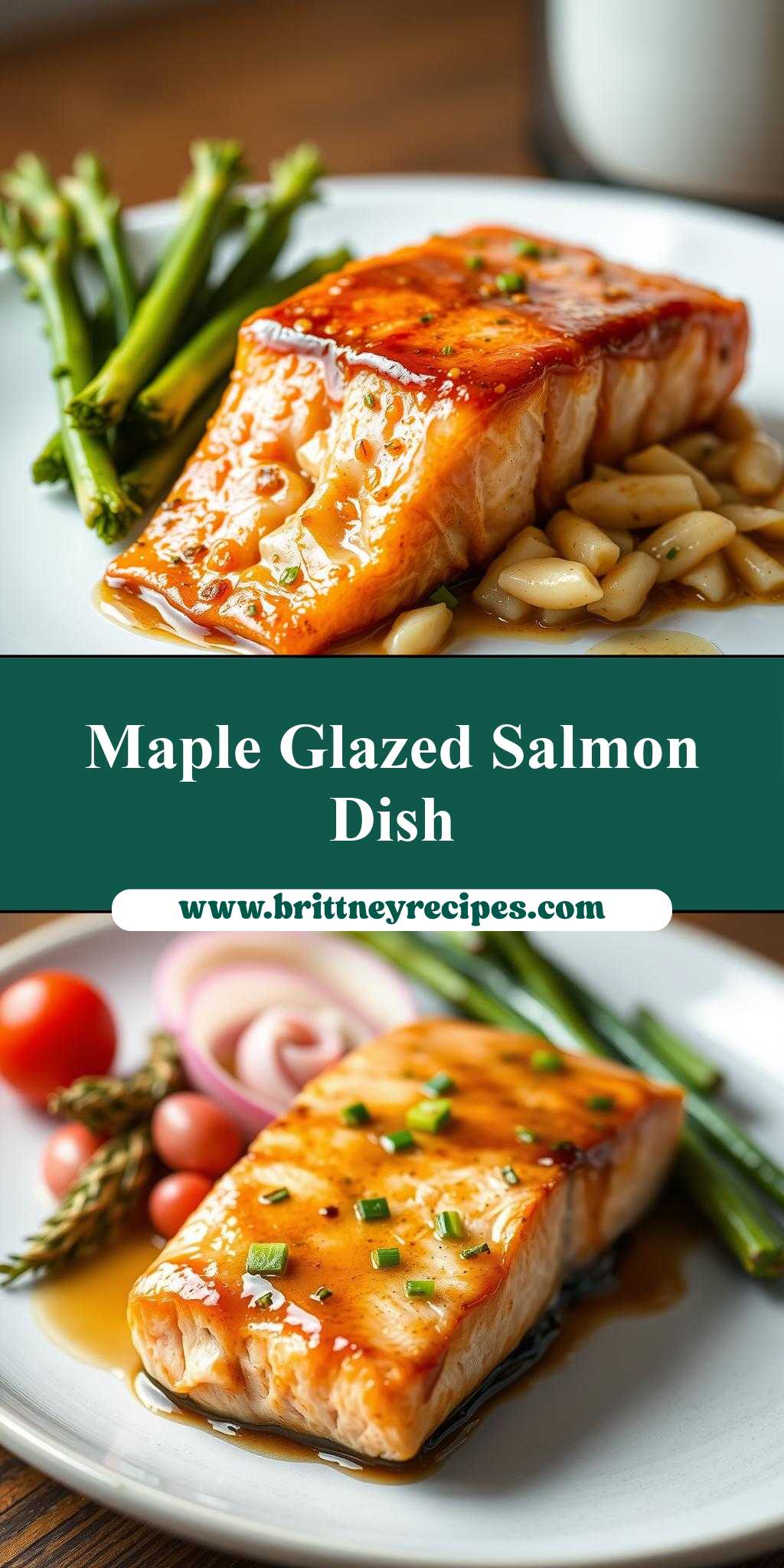What sets a truly unforgettable weeknight dinner apart from the rest – for me, it’s the perfect balance of flavors like the sweetness of maple and tanginess of Dijon in this easy homemade glazed salmon recipe, made with just a few key ingredients including fresh salmon fillets and a hint of Dijon mustard, perfect for a quick family favorite dinner, save this idea for your next easy meal inspiration.
Maple Dijon Glazed Salmon
Introduction
Imagine a dish that is as easy to make as it is impressive to serve, with flavors that dance on your palate and a presentation that is sure to delight. Welcome to the world of Maple Dijon Glazed Salmon, where the sweetness of maple syrup, the tanginess of Dijon mustard, and the richness of salmon come together in perfect harmony. This recipe is a masterclass in balance and simplicity, using everyday ingredients to create a culinary experience that is both creative and accessible. Whether you’re a seasoned chef or a beginner in the kitchen, this dish is sure to become a staple in your repertoire, perfect for special occasions or a quick weekday dinner.
Why This Works
- The combination of maple syrup and Dijon mustard creates a flavor balance that is both sweet and tangy, complementing the rich flavor of the salmon perfectly.
- The ease of preparation makes this dish accessible to anyone, regardless of their culinary experience. With just a few ingredients and simple steps, you can create a restaurant-quality meal in the comfort of your own home.
- The impressive results with minimal effort make this recipe a go-to for entertaining. The glaze adds a luxurious touch that is sure to impress your guests, and the best part is, it’s incredibly easy to achieve.
Key Ingredients
The key to this dish lies in its simple yet powerful ingredients. You will need:
– 4 salmon fillets (6 ounces each), preferably wild-caught for the best flavor and texture.
– 1/2 cup of maple syrup, which provides the sweetness and depth to the glaze. You can substitute this with honey if you prefer, but keep in mind the flavor will be slightly different.
– 1/4 cup of Dijon mustard, which adds a tangy and creamy element to the glaze. Whole-grain mustard can be used as a substitute for a slightly coarser texture.
– 2 tablespoons of olive oil, used for cooking the salmon and adding a richness to the dish.
– 2 cloves of garlic, minced, which add a subtle aroma and flavor. You can adjust the amount to your taste or omit it altogether if you’re not a fan of garlic.
– Salt and pepper, to taste, for seasoning the salmon before glazing.
Optional ingredients include fresh parsley or dill for garnish, which add a pop of color and freshness to the dish.
Instructions
- Step 1: Begin by preheating your oven to 400°F (200°C). While the oven is warming up, prepare your ingredients. Rinse the salmon fillets under cold water, pat them dry with a paper towel, and season with salt and pepper.
- Step 2: In a small saucepan, combine the maple syrup, Dijon mustard, and minced garlic. Place the saucepan over medium heat and whisk until the glaze is smooth and warm. Be careful not to let it boil, as it can quickly become too thick.
- Step 3: Brush the olive oil onto a baking sheet lined with parchment paper. Place the salmon fillets on the baking sheet, leaving a little space between each fillet to ensure even cooking. Brush the maple Dijon glaze generously over each salmon fillet, making sure they are well coated.
- Step 4: Place the baking sheet in the oven and bake for about 12-15 minutes per pound, or until the salmon is cooked through and flakes easily with a fork. The internal temperature should reach 145°F (63°C). Remove the salmon from the oven and let it rest for a few minutes before serving. Garnish with fresh parsley or dill, if desired.
Handy Tips
- Make sure to not overcook the salmon. It should be cooked until it just flakes with a fork, to retain its moisture and flavor.
- For an extra crispy top, broil the salmon for an additional 1-2 minutes after baking. Keep a close eye on it to prevent burning.
- Consider the quality of your ingredients. Fresh and high-quality salmon, real maple syrup, and good Dijon mustard will make a significant difference in the flavor of your dish.
Heat Control
Heat control is crucial in this recipe, especially when cooking the salmon. The oven should be preheated to 400°F (200°C) to ensure the salmon cooks evenly and thoroughly. When heating the glaze, medium heat is recommended to prevent it from becoming too thick or burning. For the salmon, baking at 400°F (200°C) for the recommended time will yield a perfectly cooked fillet. Always check for doneness by flaking the salmon with a fork; it should flake easily and be opaque throughout.
Crunch Factor
The crunch factor in this dish can be added in several ways. Broiling the salmon for a short time after baking can give the top a nice crispy texture. Additionally, serving the salmon with a side of roasted vegetables or a fresh salad can add a satisfying crunch to the meal. If you prefer a crunchy element directly on the salmon, a sprinkle of toasted almonds or sesame seeds before serving can provide a delightful textural contrast.
Pro Kitchen Tricks
- For a more intense flavor, let the salmon marinate in the refrigerator for 30 minutes to an hour before baking, after applying the glaze.
- Use a meat thermometer to ensure the salmon is cooked to a safe internal temperature, especially if you’re unsure about the doneness.
- Keep the glaze warm while the salmon is baking by placing the saucepan over low heat or by using a thermos. This way, you can brush additional glaze over the salmon during the last few minutes of baking for an extra sticky and caramelized top.
Storage Tips
- Leftover salmon can be stored in an airtight container in the refrigerator for up to 3 days. It’s best to let it cool completely before storing.
- For reheating, place the salmon in the oven at 300°F (150°C) for about 10 minutes, or until warmed through. You can also reheat it in the microwave, but be cautious of overcooking.
- The maple Dijon glaze can be made ahead and stored in the refrigerator for up to a week. Simply warm it up before using.
Gift Packaging Ideas
If you’re considering gifting this dish, perhaps for a dinner party or as part of a gift basket, presentation is key. You can place the glazed salmon in a decorative tin or a ceramic dish, garnished with fresh herbs. Accompany it with a side of roasted vegetables or a salad in a separate container. For a more rustic approach, wrap the salmon in parchment paper and tie it with twine, adding a small jar of the maple Dijon glaze on the side. Don’t forget to include a card with reheating instructions and a personal message.
Flavor Variations
- Spicy Twist: Add a teaspoon of hot sauce (like sriracha) to the glaze for a spicy kick.
- Herby Delight: Mix in some chopped fresh herbs (like dill, parsley, or thyme) into the glaze for added depth of flavor.
- Asian Inspiration: Replace the Dijon mustard with soy sauce and add some grated ginger to the glaze for an Asian-inspired flavor profile.
Troubleshooting
- Texture Problems: If the salmon becomes too dry, it might be overcooked. Try reducing the cooking time or checking the internal temperature more frequently.
- Ingredient Replacements: If you don’t have maple syrup, honey or agave nectar can be used as substitutes, though they will change the flavor slightly.
- Over/Undercooking Signs: Undercooked salmon will be raw and opaque, while overcooked salmon will be dry and flake excessively. Aim for a cooked-through but still moist fillet.
FAQs
- Can I freeze it? Yes, you can freeze the glazed salmon before baking. Simply place the glazed salmon fillets on a baking sheet lined with parchment paper and put it in the freezer until frozen solid. Then, transfer the frozen fillets to a freezer-safe bag or container for storage. When you’re ready to cook, bake from frozen, adding a few extra minutes to the cooking time.
- Is it gluten-free? Yes, this recipe is gluten-free, making it suitable for those with gluten intolerance or sensitivity, provided that the Dijon mustard used is gluten-free.
- Can I double the recipe? Absolutely, this recipe can be easily doubled or tripled for larger gatherings. Just ensure you have enough baking space for all the salmon fillets and adjust the cooking time slightly if necessary.
Conclusion
The Maple Dijon Glazed Salmon is a testament to the magic that happens when simple, high-quality ingredients come together in harmony. This recipe is not just about cooking a meal; it’s about creating an experience that delights the senses and brings people together. Whether you’re a food enthusiast, a busy parent, or an aspiring chef, this dish is sure to become a favorite in your household. So go ahead, experiment with the flavors, share it with your loved ones, and enjoy the process of creating something truly special. Happy cooking, and let the feast begin!

